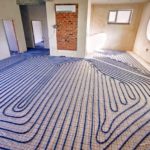Vinyl flooring in outdoor areas – yes or no?
vinyl flooring is considered to be a robust and resistant flooring that offers numerous advantages.
However, the laying of a vinyl floor in outdoor areas is not recommended in principle.
Find out in this article why this is the case – and which floor coverings are better suited for outdoors than vinyl floors.
While vinyl floors are absolutely convincing indoors and almost can be installed in any room, there are essential outdoor areas Influencing factors that add too much to the material:
Why is vinyl flooring not suitable for outdoor use?
Vinyl floors primarily react to heat.
When the temperature rises, the material expands considerably, and when the temperature drops, it tightens massively.
The interplay of wetness and dryness can also cause permanent damage to the vinyl floor.
In the outdoor sector, neither strong temperature fluctuations nor alternating wet and dry periods can be avoided.
Direct sunlight and extreme heat followed by the cloud-breaking thunderstorm in summer, sizzling cold, freezing fog or snowfall in winter – due to its pronounced shrinkage and stretching behavior, the vinyl floor would change the weather conditions outside, on the terrace or balcony in the long run.
Also for outdoor installation in covered plants, a vinyl floor is not provided for.
Thus, the sun can heat the ground in a conservatory to over 50° degrees, which leads to the swelling of the vinyl floor. Even the high temperature differences between summer and winter in garden houses would not be long withstand the vinyl flooring.
Even if manufacturers are repeatedly launching vinyl floor coverings on the market that have also been approved for outdoor installation, there are still alternatives that are more suitable for outdoor use.
Alternative Outdoor flooring
Floor ingescent outdoors must meet special requirements.
The different variants of outdoor floors differ in terms of appearance, required base and type of installation, as well as properties in terms of weather resistance, frost-freeness or resistance.
In addition to tried-and-tested materials such as ceramic tiles, natural stone, concrete or real wood, there are also modern surfaces made of plastic, which promise a long-lasting and easy-care flooring outdoors.
Especially artificial stone slabs or floor coverings made of WPC (Wood Polymer Composite) – a mixture of wood fibres and thermoplastic plastic – are enjoying increasing popularity. Visually and haptically, WPC boards hardly differ from their natural competitors, but are easier to install and are characterized above all by their higher resistance compared to real wood.

